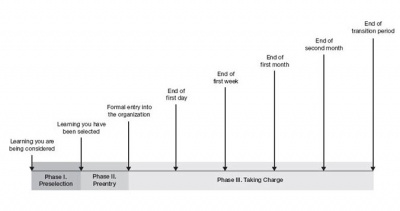90 Days - Part 1: Promoting Yourself
Contents
[hide]Summary
Promoting yourself involves letting go of the old, and embracing the new. It's not to be confused with the term promotion from a PR sense, but literally promotion, as I received a promotion from Sr. Manager to Director of (fill in the blank). In taking on a promotion, one often has to relinquish control of items they may be used to working, and expand their horizons with Accelerating Your Learning.
This section's areas involve:
- Establishing a Clear Breakpoint
- Hit the Ground Running
- Assessing Vulnerabilities
- Watching Out For Your Strengths
- Relearn How to Learn
- Rework Your Network
- Beware "Holdbacks"
Clear Breakpoint
Transitions take many forms, an internal promotion, moving to a new department, a new company, or perhaps shifting from a full time corporate job to a start-up. My transition from Comcast to MetLife provided a clear breakpoint from a specific job scope at a previous company to a similar job scope at a new company. Other transitions can provide unique challenges, such as being promoted into a new role, but having some responsibilities you must juggle from your previous role before transitioning, or worse, having to manage both old and new roles during an overlapping period.
Key elements for myself will involve ensuring clearly defined job buckets and responsibilities; org structures, job roles, processes, etc will likely be similar, but there will be specifics that are different from previous companies. Assume re-learning, not that things remain constant.
Hit the Ground Running
Establish pre-entry planning (ie this document) to ensure goals / accomplishments are outlined; what is objective of day 1, end of week 1, end of 30/60/90 days.
High Level - Tactical 30 Day Items
- MetLife Corporate Values: Learn and align to MetLife corporate values, policies, and procedures. Establish goals within framework of being a corporate citizen.
- Job Role Expectations: Understand expectations set with MetLife’s position. Ensure development of strategic plan and projects will align, meet and exceed these expectations consistently. Align against major bucket; WFM, Telephony Technology, Desktop Technology, Outsourced Partners, Reporting & Analytics, PMO, Process Engineering & Compliance.
- Day 1 Collaboration: Make effective teamwork a priority from day 1. Establish 1-on-1 & group meetings with immediate team. Understand and build on strengths of team, clear & open communications to build on existing synergies.
- Establish Goals & Prioritize: Discover and understand goals and prioritization of MetLife’s existing projects. Leverage as foundation to build on as new initiatives are brought on.
- Cross-Department Collaboration: Business Ops, IT and applicable department introductions. Emphasis on maintaining open communications – desire to align and tackle both strategic initiatives and tactical work collectively. Establish routines to support on-going cross-departmental collaboration.
- Adopt / Build Strategic Road Map: Discover and/or build strategic road map based on current projects – sort / integrate non-project based work-streams. Ensure current team workload aligns to desired business outcomes.
- IT Alignment: Discover, align, support practices which build on IT’s ITIL or BSM methodology.
- KPI’s -> Business Outcomes: Understand current KPI’s in place to measure success for goals. KPI’s adequately measure whether strategic imperatives meet desired business outcomes.
- Report Out 30 Day: Collection of data through first 30 day discovery period and synchronize with management. Re-check to ensure alignment, identification of strengths / risks.
Full 30-60-90 tactical plan in working document (transition internally)
Assess Vulnerabilities
This section is an offline worksheet which assesses my problem preferences and diagnoses risk areas based on which problems I am most and least eager to solve. It works across two axis; one identifies potential blind spots across technical, political and cultural areas, while looking across the various organization areas; HR, Finance, Marketing, Operations and R&D.
Watch Out For Strengths
A beware section that emphasizes that it's important to watch out for strengths, and attention to detail. While attention to detail in areas that one feels they are strongest in on the surface can be positive, it represents an area of risk if one takes too much control. Leverage people, allowing them to make their own contributions without disruptive oversight.
Relearn How to Learn
Avoid becoming obsolete by refusing to become brittle; an attitude of the fact that the new role/job also involves a high degree of learning is critical. Because many professionals are almost always successful at what they do, they rarely experience failure. And because they have rarely failed, they have never learned how to learn from failure. So whenever their . . . learning strategies go wrong, they become defensive, screen out criticism, and put the “blame” on anyone and everyone but themselves. In short, their ability to learn shuts down precisely at the moment they need it the most.[1]
Rework Your Network
Proactively restructure advisers and council; discussed in more detail in section 9, importance of developing technical, political and personal council. Consider asking for mentor associated with transition to new role, and establishing a monthly review process with that mentor.
Beware Holdbacks
This section in promoting yourself involves making sure you have visibility into pitfalls of relationships with colleges as you are promoted into a new role. Specific examples involve situations where a former peer is now someone you supervise, and acceptance of that change. Even in a new role, coming in as a new team leader has risks that arise. Mitigate through clear and open communications, well documented specific issues, projects are going to be dealt with, and which are not. Prioritization (even if "everything" needs some sort of improvement) is key to ensuring you maintain alignment.
Notes
- Jump up ↑ Chris Argyris, “Teaching Smart People How to Learn,” Harvard Business Review, May–June 1991.
